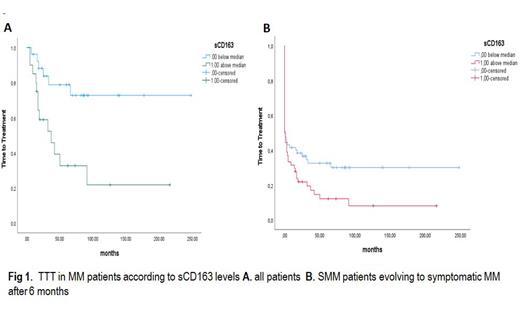INTRODUCTION
Tumor associated macrophages (TAM) constitute a major part of the bone marrow microenvironment and play a pivotal role in growth of various hematologic malignancies, such as Multiple Myeloma (MM). Cytokines secreted by TAM, such as hemoglobin scavenger receptor CD163, can be detected in their soluble form (sCD163) and reflect the TAM burden. It was recently published that bone marrow TAMs protect neoplastic plasmacytes from chemotherapy-based apoptosis. In our study, we aimed to investigate the clinical utility of sCD163 in patients with Multiple Myeloma.
PATIENTS AND METHODS
One hundred and nineteen patients were included in the study of whom 80 had symptomatic MM, 30 appeared to have SMM and 8 had MGUS. Clinical and laboratory characteristics were reviewed, after patients' informed consent form. Their median age was 68 yrs (range, 30-89), 53% were men and 47%women; 39%, 27%, and 35% of MM patients were staged ISS1, ISS2 and ISS3 respectively. Serum sCD163 was tested in frozen sera collected at patients' diagnosis and in 30 healthy individuals (HI) . Measurements were performed by ELISA (Duo-Set R&D Quantiquine) according to the manufacturer's instructions. Median value of variables was used as the cut off point. Median time to treatment (TTT) was 0 months (range,0-248) in MM patients and median overall survival (OS) was 67 months (range, 0-248). Statistical analysis was performed with the SPSS v.26 software.
RESULTS
Median sCD163 was 26618 pg/ml (11831- 35548) in HI, 24366 pg/ml (13166 - 27429) in MGUS, 27665 (18266-39088) pg/ml in SMM, and 27870 (20720-37478) pg/ml in MM patients.Significantly lower levels of CD163 were observed between MGUS and HI (p=0.001) and HI and MM patients (p=0.015). Shorter time to treatment was observed in all MM patients including SMM with sCD163 levels above median (p = 0.034). Patients who became symptomatic after 6 months of diagnosis were studied separately, with levels above the median indicating a shorter time to therapy (p=0.003). Also, a trend of shorter overall survival was observed in all patients (MM, SMM, MGUS) with levels of CD163 above median (p=0.07).
CONCLUSION
Our findings reveal that serum sCD163 levels differed in patients with MGUS, SMM, MM, and HI, and could predict TTT in MM, indicating that cells of the monocyte-macrophage lineage may play a role in disease pathophysiology and progression. sCD163 could eventually prove to be a significant prognostic factor in MM.
Disclosures
Kyrtsonis:Janssen, Amgen, Takeda, GSK: Honoraria; Integris Pharma: Membership on an entity's Board of Directors or advisory committees.


This feature is available to Subscribers Only
Sign In or Create an Account Close Modal